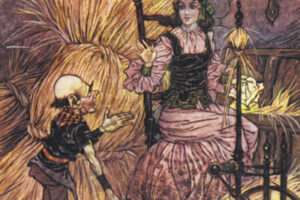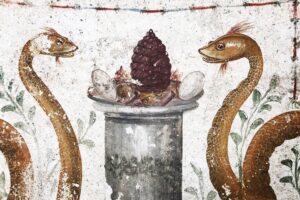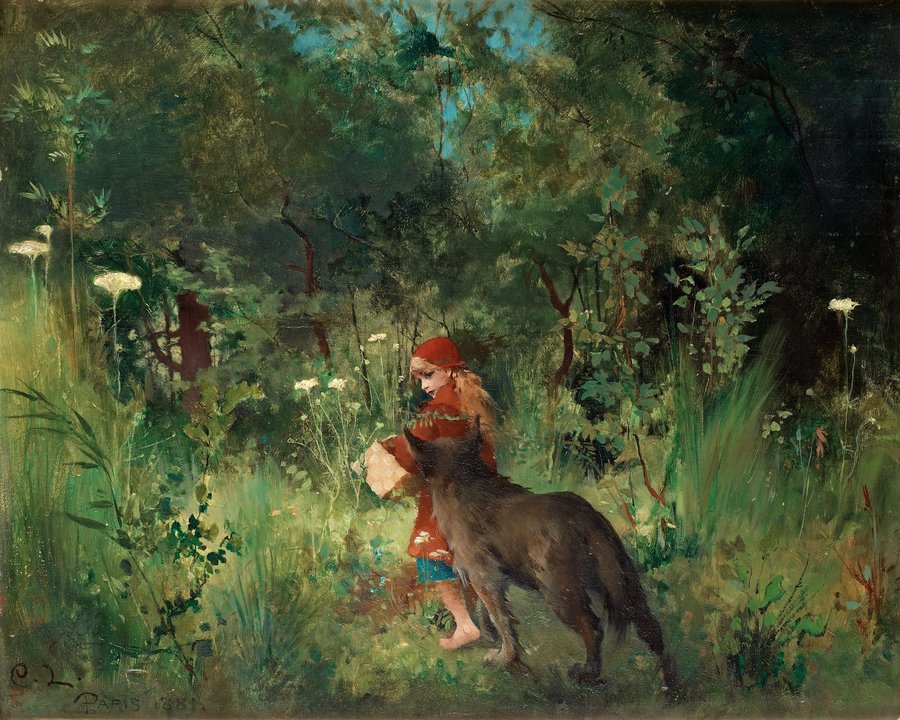
Little Red Riding Hood, a female initiation rite
Little Red Riding Hood, a female initiation rite
by Hasan Andrea Abou Saida
The fairy tale of Little Red Riding Hood, widespread in ancient times and mainly in central-northern and southern Europe, is one of the most famous and ancient tales known, and its plot reveals deep and secret primitive initiatory knowledge. The most popular version, collected and revised by the Brothers Grimm in their book “Kinder -U. Hausmärchen” of 1812, is only one of many existing versions. The fairy tale was already told in 14th century France, and the oral traditions of the European territories spread many different plots of the same story. A very different version is told by Charles Perrault in The Tales of Mother Goose in 1697, where Little Red Riding Hood is made to undress by the wolf disguised as a grandmother, and then eaten, without the classic happy ending. In a Romagna myth reported by Anselmo Calvetti in his book “Antichi miti di Romagna. Folletti, spiriti delle acque e altre figure magiche nelle tradizioni romagnole” (Ancient Myths of Romagna. Goblins, water spirits and other magical figures in the traditions of Romagna) of 1987, the plot of the fairy tale is just as different. Little Red Riding Hood walks alone along the road to her grandmother’s house. When she leaves the path, to stop and pick some flowers under the trees, she is apostrophised by the wolf who convinces her to share the pancakes and the wine her mother has given her. The wolf convinces her to share the pancakes and wine that her mother has given her. The wolf then arrives at her grandmother’s house, opens the door imitating the girl’s voice and swallows the old woman. When Little Red Riding Hood arrives, the wolf, disguised in the old woman’s clothes, serves the girl some dishes prepared with parts of her grandmother’s body. The young protagonist, unaware, agrees to eat them and as soon as she has finished, she too is devoured. A hunter, who was walking in the woods, enters the house when he sees the door open and, finding the wolf asleep, disembowels the animal, thus freeing the girl and her grandmother 1.
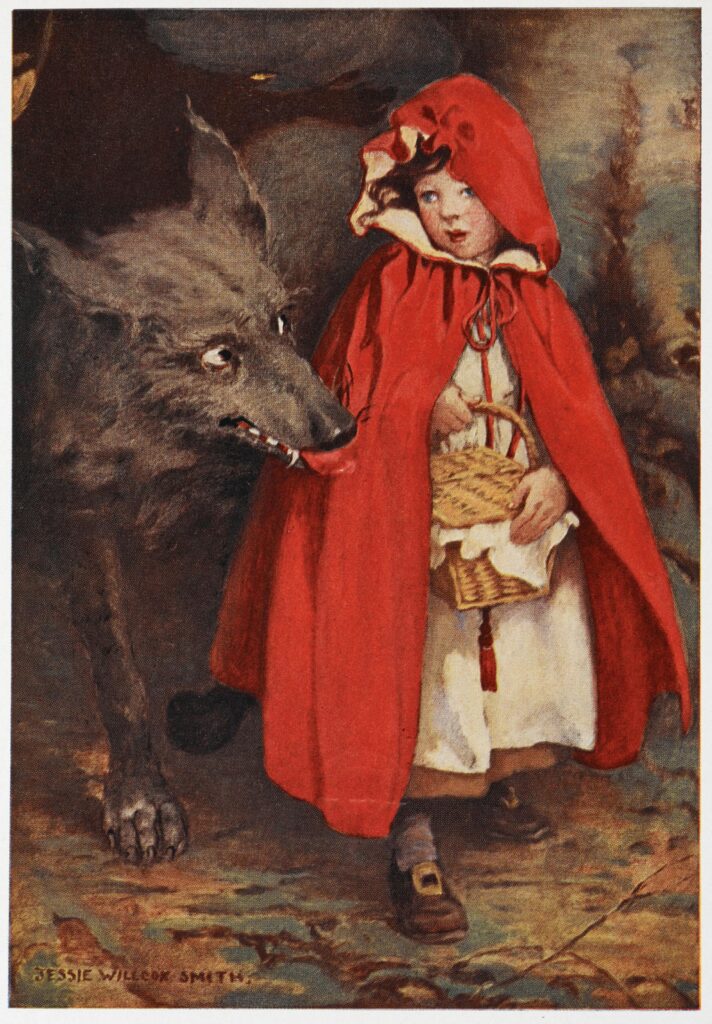
In the five versions of the tale published in the magazine “Mélusine”, the wolf induces the unsuspecting girl to eat parts of her grandmother’s body and drink her blood, despite a bird or a cat trying to warn her of the deception the wolf is carrying out. The same episode of involuntary cannibalism in Little Red Riding Hood is also present in a version that C. Schneller collected in Trentino and published in Innsbruck in 1867. The Ogre, who plays the role of the wolf, offers the girl rice, meatballs and wine, which are in fact her grandmother’s teeth, cheeks and blood 2. In a Romagna version collected by Mrs Angelina Testa in 1974 and published by the scholar and folklorist Anselmo Calvetti, Little Red Riding Hood goes into the woods to visit her sick grandmother. She then meets the wolf who is eating her grandmother’s breakfast. The wolf precedes the girl to her grandmother’s house, devours the old woman, puts on her clothes and gets under the covers of her bed. From this point, Anselmo Calvetti sets out Angelina Testa’s version of the tale in more detail:
When she arrives at her grandmother’s house, Little Red Riding Hood tells the wolf, whom she does not recognise under her grandmother’s clothes, what happened to her in the woods. Then she says that the long walk has made her hungry.
“If you are hungry,” says the wolf, “open the cupboard and eat two or three tortellini that are left in a small plate”. While Little Red Riding Hood is eating, the wolf murmurs: “Magna agli uréc dla tua nona! (Eat your grandmother’s ears).” “Are you still hungry? There are two or three lasagnas in a pan” and then murmurs “Magna al budél dla tua nona! (Eat your grandmother’s guts).” “Are you still hungry? There are two or three manfettini left in a pan” and murmurs “Magna i dent dla tua nona! (Eat your grandmother’s teeth).” “Are you thirsty? There is a small bottle of red wine in the corner cabinet.” “Drink the blood of your granny! (Drink your grandmother’s blood).” After Little Red Riding Hood has eaten and drunk, the wolf says to her, “If you are tired, come into bed next to me.” “Grandma what long hair you have!” – exclaims the little girl – “I’ve let my hair down” – exclaims the wolf. “What big feet you have!” – “Trop caminè (Too much walking).” – “What big hands you have!” – “Trop filé (Too much spinning).” – “What big ears you have!” – “Too much listening.” – “What big eyes you have!” – “You look too much.” – “What a big nose you have!” – “Too much snuff!” – “What a big mouth you have!” – “Ham!” and in one mouthful the wolf swallows the girl. A hunter, passing by the grandmother’s house, finds the door open and sees the wolf snoring lying on the bed. With a knife he opens the wolf’s belly from which Little Red Riding Hood and the grandmother emerge, still alive. The hunter accompanies the girl to the village, to her parents, and advises her to keep away from the dangers of the forest 3.
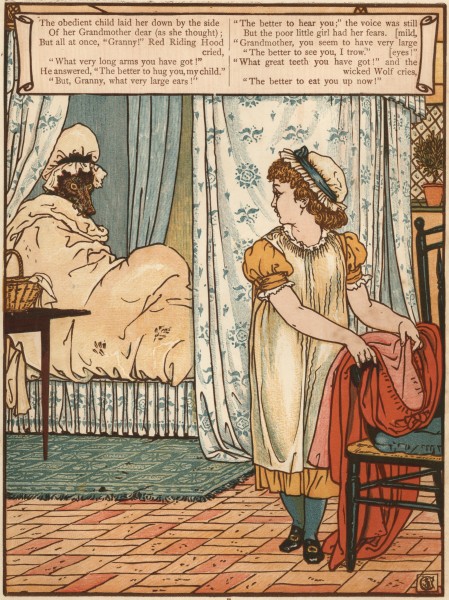
Moreover, among the more archaic versions of the fairy tale, there is another plot, collected by Anselmo Calvetti himself in 1969 in Sant’Omero, in the province of Teramo, from Mrs Maria Di Didomenicoantonio. Unlike the other versions, Little Red Riding Hood listens to the warnings of the picerilli or picurilli (little animals) and, under pretexts, refuses to eat the schiacciata (a flat bread), made from her grandmother’s guts, the teeth in the loaf of bread, and to drink the blood in the jug. He asks the wolf for permission to go away to do his business. Not trusting her, the wolf ties the girl up with a rope and lowers her into the stable below. Little Red Riding Hood frees herself from the strings from which she hangs two goats. The wolf pulls the rope and, hearing the bleating of the beasts, realises that the girl has escaped 4.
The elements of the archaic Little Red Riding Hood fairy tale, such as the choice of a path through the woods, the unsuspecting ‘cannibalistic meal’ of the grandmother and the absence of a rescue by the hunter, lead us to think – as did Anselmo Calvetti – that the entire narrative, seen in a symbolic and analogical light, was most probably originally a prehistoric female initiation rite, a ritual of passage for a new member into the adult community. During the ritual, a neophyte would encounter her totem animal (the wolf) and her soul would be swallowed or torn to pieces by the animal’s spirit, and then brought back to life. This liturgy, which corresponds to the rites of youth initiation, has always been practised by the primitive peoples of Africa, America and Oceania and, in prehistoric times, must also have been practised by the prehistoric hunting communities settled in Europe.
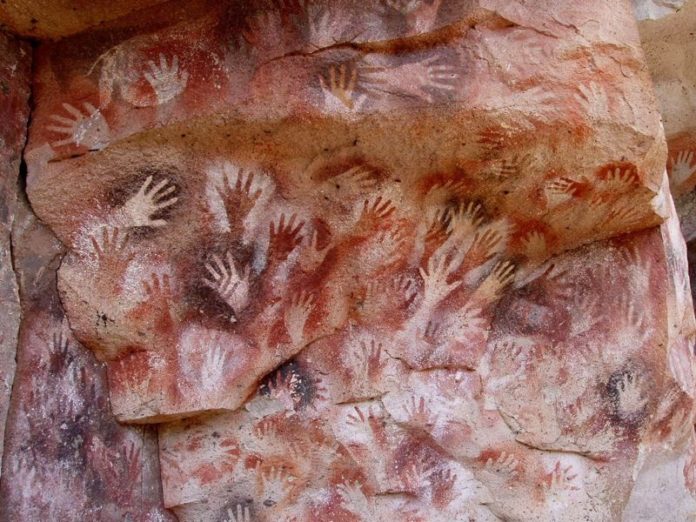
Fairy tales, as the anthropologist and ethnologist Giuseppe Cocchiara observed, represent, together with all popular poetry, a true ethnographic document. In the fable, traditions, customs and beliefs of very ancient origin survive, and these have often disappeared as genuine folk traditions and rituals. Among all folk tales, the so-called magic tales, according to the definition and structure given by the Russian anthropologist Vladimir Jakovlevič Propp in his book “The Historical Roots of Fairy Tales”, are characterised by the same approach, and are particularly useful for reconstructing the unfolding of archaic initiation rites. The forest, which countless cultural traditions designate as the place for the initiation of young people, is said to represent the scene of a complex liturgical sequence, the participation of which would allow the neophyte, who was strictly forbidden contact with family members, to enter the social world of the tribe. Once the preparation period was over and the young person had been given useful survival instructions, the adults of the community would set about building a hut made of branches, often in the shape of animals, through the narrow opening of which they would then introduce the neophyte, after subjecting him to painful incisions and the ingestion of intoxicating substances. This process, which ended with the liberation of the subject from the simulacrum, would be used to stage the death and rebirth of a member of the community, as a moment of transition between childhood and full maturity 5. Only by entering into communion with the totemic animal spirit of one’s clan (or individual) was the young person transformed and able to become fully an adult member of the community.
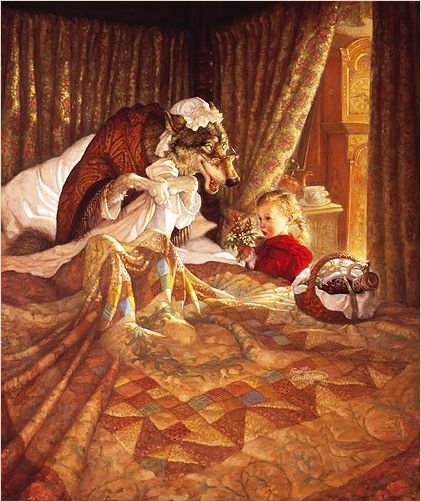
During the narration of the fairy tale, Little Red Riding Hood stops several times in the forest and often meets the wolf, her spirit ally, who demands a symbolic offering of food from the girl (neophyte) to complete the initiation ritual in her grandmother’s house. The wolf, disguised as Little Red Riding Hood’s grandmother, represents the ancient ancestor from whom the whole clan or tribe descends, embodying the divine qualities and attributes present in the clan. The wolf, in European mythologies, is both a destructive and a fecund animal. Through destruction, the wolf brings about metamorphosis and transformation, and as a psychopomp animal, guides the souls of the living and the dead across the threshold into the spirit world. In the archaic Greek world, there were rituals involving the use of masks and implying a transformation of the participants, often involving a transmutation into animals or the personification of ancestors or gods. At the sanctuary of Mount Lycaeus, in Arcadia, dedicated to Zeus Lykaios, initiation rituals were held where human flesh mixed with that of certain animals was served: those who tasted this food were believed to have been transformed into wolf-men (lykanthropoi). Once they had shed their clothes, they swam across a pond and lived for nine years in the mountains in the guise of wolves. In the tenth year the initiates crossed the pond again and became men again 6. Also in Ancient Greece, female initiations took place in Braudron at the sanctuary dedicated to the goddess Artemis, the Lady of the Hunt and of the Beasts, where young women, imitating the movements of the bear, the animal sacred to the goddess, took possession of her powers and identified with an aspect of the goddess herself. The ‘bears of Brauron’ were preparing to enter the polis as wives and mothers 7.
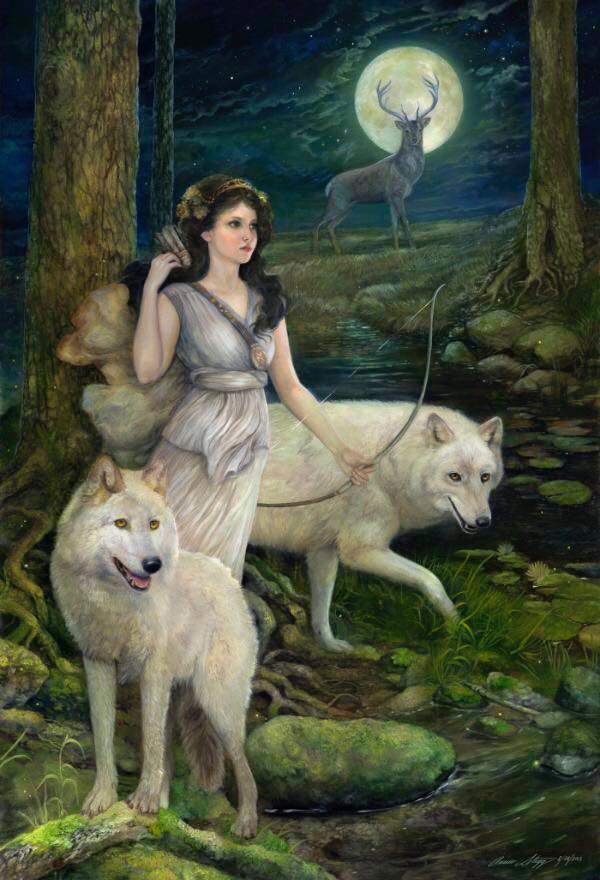
The most important initiation rite for every woman is that of menarche, or the first menstruation. It is the moment when every girl becomes a woman, the beginning of a journey of spiritual initiation that culminates in menopause. In ancient times, this sacred rite of vital importance was celebrated with a great feast together with all the other women of the clan, and it was believed that the dreams of the girls during their first menstruation contained valuable indications about their future. The colour red and the blood in Little Red Riding Hood are among the most prominent elements in the story and indicate the transition from a girl to a girl. These initiation rites are an element of continuity with very ancient ceremonies dating back to the prehistoric Neolithic period, where every divine female and male aspect belonged to the Great Mother and women had central power as tribal chiefs and spiritual leaders. In the tale of Little Red Riding Hood, the feminine is predominant and the protagonist of the story, where the girl, the mother and the grandmother, symbolically represent the three aspects of the Great Mother: the Young, pure and representative of the new beginning, the Mother, generatrix of life, helpful and compassionate, and the Wise Old, representing the ancestors and the culmination of life in total knowledge and experience. The three aspects of the Great Mother also express the concept of birth-life-death-rebirth present in every natural and cosmic cycle, and especially in the lunar cycle. The feminine cycle and the lunar cycle are intimately connected and the rhythm is the same; in ancient cultures the woman and the Moon danced in perfect synchrony. In archaic matriarchal society, the woman was a shaman, warrior and head of the family, and the female rites of passage were given special consideration and held in higher esteem. It is therefore possible that the tale of Little Red Riding Hood can be traced back to the period of a Neolithic “matriarchy”, where the wolf was considered a totemic animal of initiation also for the female group and not only for the male neophytes.
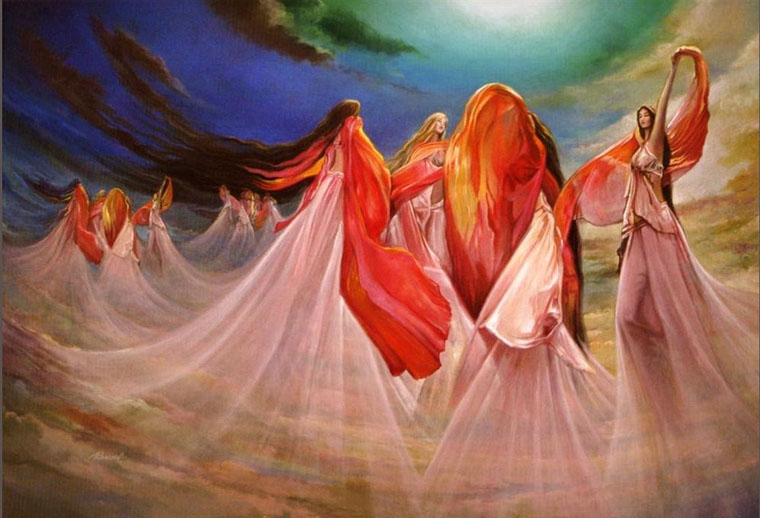
In the various versions of the fairy tale, it is noted that the girl does not have a real name and is instead called by a nickname that refers to her hood and its colour. The red hood, an element that can be found in many traditional attestations as a characteristic attribute of popular magical figures, is said to be an icon typically associated with magical beings, whose existence straddles the world of the living and the dead. Furthermore, Little Red Riding Hood, which gives its name to the fairy tale and to the little girl in it, could be a symbolic reference to the Amanita Muscaria mushroom, a mushroom with psychotropic qualities, used as a psychotropic substance in the initiation ritual, and with which the neophyte was identified. According to Wasson’s studies, amanita muscaria was used in ancient times by European tribal populations as a magical ingredient of fundamental importance in causing profound changes in the initiate’s state of consciousness. The greatest concentration of active ingredients that enable this change of state of consciousness lies in the red and white cap of the mushroom, also known as the ‘Red Cap’. By dressing up as the mushroom, the girl magically assumes the same powers and qualities as the spirit of the Amanita Muscaria, and by feeding on the flesh and blood of her grandmother, her ancestor and a mushroom herself, she allows access to the inner underworld of the neophyte, guided by the spirit of the wolf (totem animal). If the girl is in fact Little Red Riding Hood, and if Little Red Riding Hood stands for Agaric Muscarius, then the grandmother is also a fungus of this species 8.
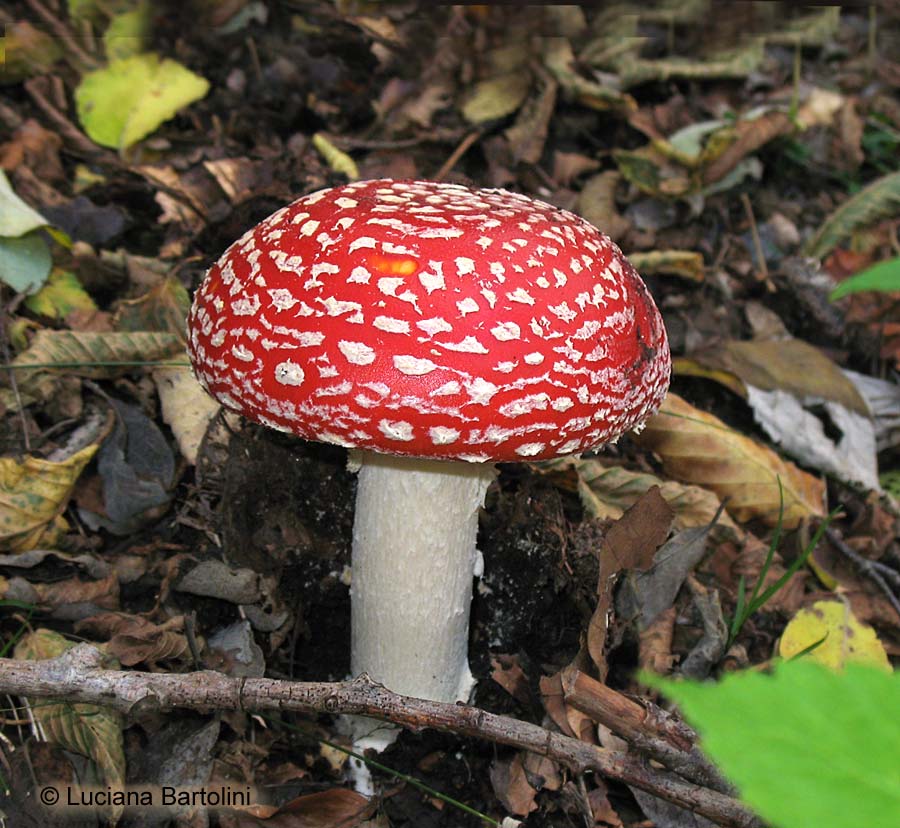
This hypothesis is confirmed by another folk tale collected by Alberto Borghini in Galliate (Novara) with a structure very similar to the Ravenna version of the tale of Little Red Riding Hood. In this tale, a little girl from Galliate goes to visit her grandmother, taking with her some pancakes prepared by her mother. On the way she begins to eat the pancakes and when she realises that she has unintentionally finished them, she stuffs cow droppings into the placemat, trying to disguise them with the remaining crumbs. The grandmother tastes the cake and, as soon as she has tasted the unpleasant taste, decides to take revenge on the girl. The next morning she goes to the child’s house, cuts her up while she is sleeping and scatters the various body parts around the room. When the mother comes home and finds out what has happened, she despairs and runs through the streets screaming. In the meantime, a monk, who was passing by, hears the desperate cry and, going to meet the mother, tells her that, with the help of a mushroom, he will be able to save the girl. So the friar goes in search of the carpophore (the “fruit” of the mushrooms) and after finding it, returns home to his mother to cook it. In this way he obtains a kind of glue with which he reassembles the body parts of the little protagonist. When the work is finished, the girl regains consciousness and no scars appear on her body, except for a slight mark around her neck 9. In this Novara version of the fairy tale, the little girl is always the neophyte and the grandmother plays the role of the wolf, the officiant of the ritual. The monk, a figure linked to the spiritual sphere, is said to be able to bring the protagonist back to life through a psychoactive mushroom, used as a magic ingredient in the ritual.
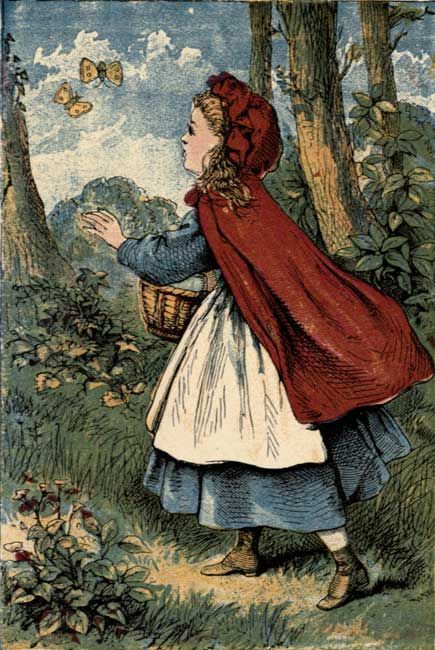
In conclusion, the story of Little Red Riding Hood hides in its plot a very ancient rite, now lost, of female sexual initiation, in which every girl, becoming fertile, is transformed into a woman and accesses the female mysteries with the help of the spirits of the ancestors and the clan.
1 Calvetti, A. (1987). Antichi miti di Romagna: folletti, spiriti delle acque e altre figure magiche. Rimini: Maggioli.
2 Calvetti, A. (1980). TRACCE DI RITI DI INIZIAZIONE NELLE FIABE DI CAPPUCCETTO ROSSO E DELLE TRE OCHINE. Lares, 46(4), 487-496. Retrieved May 21, 2021, from http://www.jstor.org/stable/44628402
3 Ibidem
4 Ibidem
5 Vannoni, G. M. (2016). Etnobotanica totemica: Cappuccetto Rosso e amanita muscaria. Quaderni di Semantica, 2, 219–227.
6 Comba, E., & Amateis, M. (2019). Le porte dell’anno: cerimonie stagionali e mascherate animali. Torino: Accademia University Press, pp. 70 – 71.
7 Ivi, pp. 144 – 145.
8 Vannoni, G. M. (2016). Etnobotanica totemica: Cappuccetto Rosso e amanita muscaria. Quaderni di Semantica, 2, 219–227.
9 Ibidem
Bibliography
Calvetti, A. (1987). Antichi miti di Romagna: folletti, spiriti delle acque e altre figure magiche. Rimini: Maggioli.
Comba, E., & Amateis, M. (2019). Le porte dell’anno: cerimonie stagionali e mascherate animali. Torino: Accademia University Press.
Gennep, A. Van. (1999). I riti di passaggio. Torino: Bollati Boringhieri.
Grimm, J. e W. (1993). Fiabe del focolare. Milano: CDE.
Perrault, C. (1957). I racconti di mamma l’oca. Torino: Einaudi. Alessandria: Edizioni dell’Orso.
Propp, V. J. (1949). Le radici storiche dei racconti di fate. Torino: Einaudi.
Schneller, C. (1979). Märchen und Sagen aus Wälschtirol. Forni: Sala Bolognese.
Wasson, G. (1968). Soma: divine mushroom of immortality. New York: Harcourt, Brace & World.

